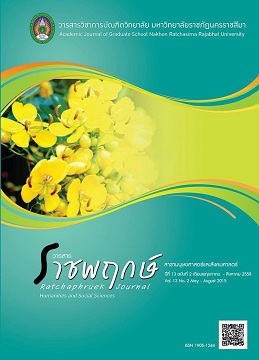นโยบายการค้าชายแดนไทย-กัมพูชากับการปรับตัว เข้าสู่ประชาคมอาเซียน : กรณีศึกษาจังหวัดสระแก้ว
Main Article Content
Abstract
การวิจัยเรื่องนี้ผู้วิจัยได้กำหนดวัตถุประสงค์ 3 ประการ คือ 1) เพื่อศึกษาและวิเคราะห์พัฒนาการของนโยบายการค้าชายแดนไทย-กัมพูชา 2) เพื่อศึกษารูปแบบ วิธีการและปัญหาของการค้าชายแดนไทย-กัมพูชา และ 3) เพื่อศึกษาผลกระทบจากนโยบายการค้าชายแดนไทย-กัมพูชา ผู้วิจัยเก็บข้อมูลจาก 1) การศึกษาเอกสาร 2) การสังเกตการณ์ 3) การสัมภาษณ์ผู้ให้ข้อมูลสำคัญจากหน่วยงานราชการส่วนภูมิภาค องค์กรปกครองส่วนท้องถิ่นและภาคเอกชน จำนวน 30 คน โดยใช้การสุ่มตัวอย่างแบบเจาะจง และ 4) การสำรวจข้อมูลจากพ่อค้าแม่ค้าในพื้นที่ตลาดจุดผ่านแดน จำนวน 400 คน โดยใช้การสุ่มตัวอย่างแบบโควต้า ผลการวิจัยพบว่า
1. นโยบายการค้าชายแดนไทย-กัมพูชานับตั้งแต่ ปี 2531-2557 มีการเปลี่ยนแปลงอย่างเป็นพลวัตรต่อเนื่องสามารถแบ่งออกเป็น 4 ช่วงดังนี้ ช่วงที่ 1 นับตั้งแต่ปี 2531-2534 เป็นนโยบายเริ่มต้นการเปลี่ยนแปลงแนวคิดและความหมายขอบข่ายเรื่องความมั่นคงของรัฐซึ่งนำมาใช้กับการแก้ไขปัญหาชายแดน ช่วงที่ 2 ปี 2535-2545 เป็นการปรับเปลี่ยนนโยบายการค้าชายแดนสู่ความร่วมมือทางเศรษฐกิจในระดับทวิภาคีและพหุภาคี ภายใต้การจัดตั้งเขตการค้าเสรีอาเซียน (AFTA) และโครงการความร่วมมือทางเศรษฐกิจในอนุภูมิภาคลุ่มน้ำโขง (GMS) เพื่อพัฒนาความสัมพันธ์กับประเทศเพื่อนบ้านและส่งเสริมการพัฒนาการค้า การลงทุนและการค้าชายแดนในภูมิภาค ช่วงที่ 3 ปี 2546-2552 เป็นนโยบายการค้าชายแดนภายใต้ยุทธศาสตร์ความร่วมมือทางเศรษฐกิจ อิรวดี-เจ้าพระยา-แม่โขง (ACMECS) เพื่อผลักดันให้เศรษฐกิจการค้าชายแดนไทย-กัมพูชา เติบโตอย่างต่อเนื่อง และช่วงที่ 4 ปี 2553-2557 เป็นนโยบายการค้าชายแดนเชื่อมโยงประชาคมอาเซียนเพื่อยกระดับพัฒนาเขตเศรษฐกิจการค้าชายแดนเพื่อรองรับการเข้าสู่ประชาคมอาเซียน
2. รูปแบบทางการค้าชายแดนไทย-กัมพูชาด้านพื้นที่จังหวัดสระแก้วสามารถแบ่งได้ 3 ลักษณะ คือ 1) การค้าชายแดนตามแบบวิถีชีวิตตลาดชายแดนท้องถิ่น 2) การค้าชายแดนนอกระบบ และ 3) การค้าผ่านชายแดน โดยมีลักษณะวิธีการค้าแบบเสรี มีวิธีการชำระเงินทั้งในแบบ เงินสด สินเชื่อ ตลาดแลกเปลี่ยนเงินนอกระบบ (โพยก๊วน) และการชำระเงินผ่านระบบธนาคาร สำหรับการขนส่งสินค้าใช้การขนส่งทางบกโดยผ่านจุดผ่านแดนถาวร จุดผ่อนปรนทั้ง 4 แห่ง และไม่ผ่านจุดผ่านแดนโดยอาศัยช่องทางธรรมชาติในพื้นที่
ปัญหาการค้าชายแดนไทย-กัมพูชา พื้นที่จังหวัดสระแก้ว พบว่า ปัญหาของภาครัฐ คือ ปัญหาการเมืองภายในประเทศที่ส่งผลต่อการเปลี่ยนแปลงนโยบายการค้าชายแดนปัญหาการบูรณาการทำงานร่วมกันของหน่วยงานในพื้นที่ชายแดนและปัญหาการลักลอบนำเข้าสินค้าผิดกฎหมาย เป็นต้น ในส่วนภาคเอกชนทั้งผู้นำเข้า-ส่งออกสินค้าและพ่อค้าแม่ค้าในพื้นที่ตลาดการค้าชายแดนพบปัญหาระเบียบพิธีการศุลกากร ปัญหาการตรวจจับสินค้าละเมิดลิขสิทธิ์ ปัญหาความแออัดของจุดผ่านแดนถาวรบ้านคลองลึกและปัญหาทางด้านภาษาอังกฤษและภาษาเขมรที่ใช้ในการสื่อสาร เป็นต้น
3. ผลกระทบจากนโยบายการค้าชายแดนไทย-กัมพูชาที่ส่งต่อพื้นที่จังหวัดสระแก้วในด้านเศรษฐกิจ สังคม การเมืองและความมั่นคง พบว่า ผลกระทบด้านบวกของนโยบายการค้าชายแดนช่วยแก้ไขปัญหาสงครามและสร้างสันติภาพเกิดขึ้นตามแนวชายแดน สร้างอาชีพและรายได้ให้กับประชาชนในจังหวัดสระแก้ว ส่วนผลกระทบด้านลบก่อให้เกิดปัญหายาเสพติด ปัญหาด้านสาธารณสุข ปัญหาการจราจรและอุบัติเหตุ และปัญหาการค้ามนุษย์ เป็นต้น
Thai-Cambodian Border Trade Policy and its Adaptation to ASEAN Community: A Case Study of Sakhao Province
The three objectives of this study were 1) to classify and analyze the development of Thai-Cambodian Trade Policy,2) to identify practices and problems related to Thai-Cambodian border trade and 3) to categorize the impact of trade policy on Sakaeo Province. The data was collected by means of 1) studyof the document, 2) observation,3) interview 30key informants in relevant provincial administration offices, local administration offices, and the private sector, using purposive sampling and 4) survey for 400 traders at border crossing points, using Quota sampling.The findings of the study were as follows:
1. The development of Thai-Cambodian Trade Policy from B.E. 2531-2557was found in 4 stages. They were 1) the initial stage (B.E. 2531-2534) where ideology and scope were changedconcerning national security that were employed in solving border conflicts; 2) the second stage (B. E. 2535-2545) where border trade policy was shifted its focus to economic cooperation at both bilateral and multilateral levels under the ASEAN Free Trade Area (AFTA) and the Greater Mekong Sub-region (GMS) in order to promote relations with neighboring countries and boost regional trade and investment; 3) the third stage where border trade policy was under Ayeyarwady, Chao Praya, Mekong Economic Cooperation Strategies (ACMECS) that aimed at sustaining continual economic growth for Thailand along its border with Cambodia; and 4) the fourth stage where the focus of border trade policy is on Thailand’s integration into the ASEAN Community.
2. Thai-Cambodian border trade practices in Sakaeo Province were divided in 3 categories-- 1) border trade based on local ways of life along the border, 2) non-formal border trade, and 3) cross-border trade. All these unregulated border trades were conducted on cash and lending payment basis through underground and official banking currency exchanges. The goods were transported overland through immigration check points, four temporarily permitted areas, and other unofficial points along the porous border.
The study also revealed the government-related border trade problems such as the impact of political instability on border trade policy, and lack of work integration among relevant offices in the border area, as well as goods smuggling into the country. In addition, the private sector-related trade problems experienced by importers, exporters, and traders in those area were the concerning customs regulations and procedures, the detection and confiscation of pirated goods, the overcrowded Ban KhlongLeuk Immigration Check Point, and language (English and Khmer) related problems
3. The positive impact from Thai-Cambodian border trade policy on Sakaeo Province revealed in the study was its contribution to the resolution of armed conflict between the two nations, and its contribution to peace making, as well as the income andjobsfor local residents. On the other hand, the study also revealed negative impacts such as drug addiction, public health problems, traffic congestion, and human trafficking.

